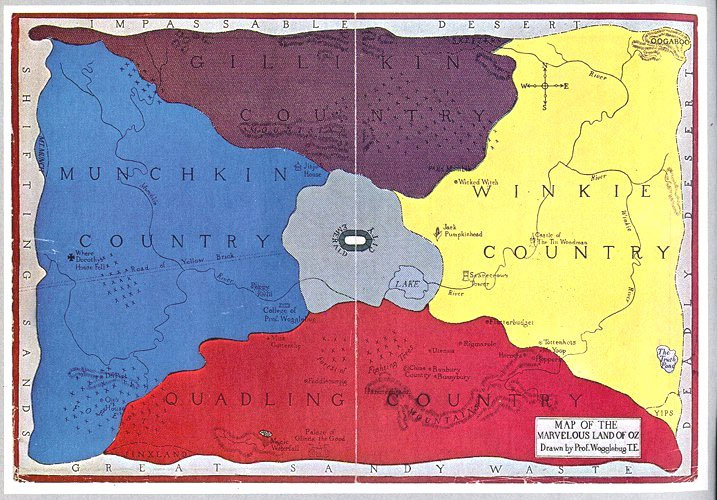The following was origanally published in the Philadelphia North American (3 October 1904). Reprinted in The Baum Bugle, Spring 1985.
WOGGLEBUG’S CREATOR TELLS OF INSPIRATION
"I was out on a California beach," said L. Frank Baum. "There was a pretty little girl I was very much interested in beside me. She was making sand pies and enjoying herself immensely, when suddenly she saw one of those little sand crabs, fiddler crabs I suppose they are.
‘Oh, what is it?’ she said.
‘A wogglebug,’ I said, unthinkingly, using the first term that popped into my head.
‘The child was delighted and ran to her parents shouting: ‘Oh, see what I’ve got! It’s a wogglebug. Mr. Baum says it’s a wogglebug.’
"The name was so catchy that the same evening my wife told me I should put the Wogglebug in ‘The Marvelous Land of Oz.’ The book was one-third written and Jack Pumpkinhead was the hero, but I brought in the Wogglebug right away.
"After that H.M. Wogglebug T.E. was the hero and has become my most popular character."
In this little anecdote the creator of the most popular fairy tale of his day and generation yesterday told the origin of the wonderful humanized insect who answers the questions which puzzle his companions every week in The North American.
At the same time he was giving his interviewer an insight into why Mr. Baum for twenty years has been charming children wherever the English language is read. For the creator of the Scarecrow, the Tin Woodman, the Gump and all the other imaginative troupe loves children.
MANY LETTERS FROM CHILDREN
"Not a day passes," he says, "but I get a letter from a child. They come sometimes singly, sometimes in batches of 50 or 100. Entire classes, where school teachers have read my stories, have written to me. I answer every one personally. When I was a child I know how, if I had received a real letter from an author whose book I’d read, I would have been the happiest boy alive.
"And if I am to do any good in this world my highest ambition will be to make children happy."
And this led to an inquiry into these fairy tales themselves, into what first suggested to Mr. Baum the idea of writing them. The answer might have been expected. It was that, in the first place, Mr. Baum had been just like most other children, a very vivacious reader of fairy tales. In the second place he had done what many other grown ones have done, told fairy tales to children.
"I demanded fairy stories when I was a youngster," he explained, "and I was a critical reader too. One thing I never liked then, and that was the introduction of witches and goblins into the story. I didn’t like the little dwarfs in the woods bobbing up with their horrors.
"That’s why you’ll never find anything in my fairy tales which frightens a child. I remember my own feelings well enough to determine that I would never be responsible for a child’s nightmare.
"Then, when I had children of my own, I used to sit in front of the grate fire and tell fairy tales to them before they were sent to bed. My wife begged me to write them down; told me they were much better than lots that were printed. I did and there you are."
Simple, isn’t it? That’s what started Mr. Baum on his way to becoming the most widely read author in the United States today.
He has written altogether sixteen books of fairy tales, every one of which is now selling.
"The Wizard of Oz" has sold 780,000 copies, the largest sale on record, and one which shows no sign of stopping.
His income from his books is larger than that of the President of the United States.
But better than all this, Mr. Baum thinks, is that he has opened up new fairy lands for children, peopled with new characters, grotesque enough to catch a child’s errant family, funny enough to amuse them, humanized enough to make them lovable.
"WHEN I WAS A BOY"
It was an odd idea thought the interviewer to endow such inanimate objects with life, and as a final question he asked Mr. Baum the origin of his curious beings who wander through his pages. And again the answer led straight back to the child.
"When I was a boy I was tremendously interested in scarecrows. They always seemed to my childish imagination as just about to wave their arms, straighten up and stalk across the field on their long legs. I lived on a farm, you know. It was natural then that my first character in this animated life series was the scarecrow, on whom I have taken revenge for all the mystic feeling he once inspired.
"Then came the Tin Woodman, named because of the oddity of a Woodman made of tin, and then Pumpkinhead, and now, of course, the Wogglebug."
The interviewer couldn’t resist it. Here was the fountain head.
"And what, Mr. Baum, did the Wogglebug say?"
But Mr. Baum only smiled.
Return to Top of Page
This web-page compiled by Chelsea Hochstetler. |





